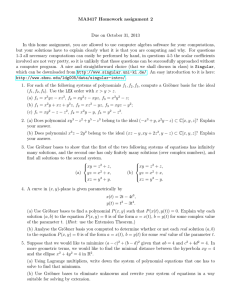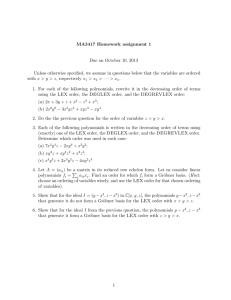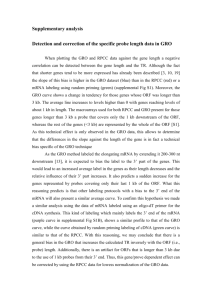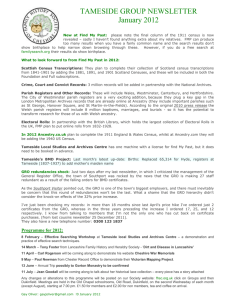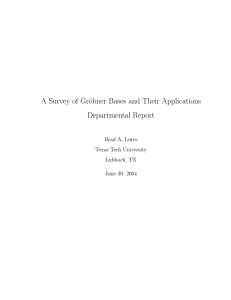Solutions to MA3417 Homework assignment 2
advertisement
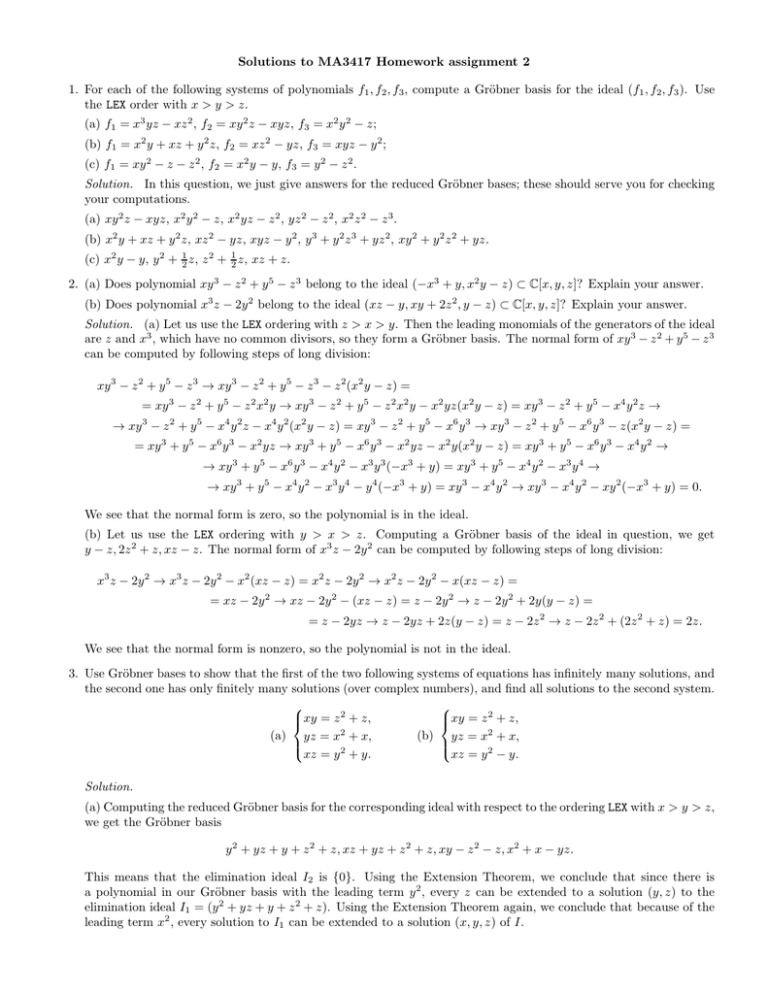
Solutions to MA3417 Homework assignment 2
1. For each of the following systems of polynomials f1 , f2 , f3 , compute a Gröbner basis for the ideal (f1 , f2 , f3 ). Use
the LEX order with x > y > z.
(a) f1 = x3 yz − xz 2 , f2 = xy 2 z − xyz, f3 = x2 y 2 − z;
(b) f1 = x2 y + xz + y 2 z, f2 = xz 2 − yz, f3 = xyz − y 2 ;
(c) f1 = xy 2 − z − z 2 , f2 = x2 y − y, f3 = y 2 − z 2 .
Solution. In this question, we just give answers for the reduced Gröbner bases; these should serve you for checking
your computations.
(a) xy 2 z − xyz, x2 y 2 − z, x2 yz − z 2 , yz 2 − z 2 , x2 z 2 − z 3 .
(b) x2 y + xz + y 2 z, xz 2 − yz, xyz − y 2 , y 3 + y 2 z 3 + yz 2 , xy 2 + y 2 z 2 + yz.
(c) x2 y − y, y 2 + 21 z, z 2 + 12 z, xz + z.
2. (a) Does polynomial xy 3 − z 2 + y 5 − z 3 belong to the ideal (−x3 + y, x2 y − z) ⊂ C[x, y, z]? Explain your answer.
(b) Does polynomial x3 z − 2y 2 belong to the ideal (xz − y, xy + 2z 2 , y − z) ⊂ C[x, y, z]? Explain your answer.
Solution. (a) Let us use the LEX ordering with z > x > y. Then the leading monomials of the generators of the ideal
are z and x3 , which have no common divisors, so they form a Gröbner basis. The normal form of xy 3 − z 2 + y 5 − z 3
can be computed by following steps of long division:
xy 3 − z 2 + y 5 − z 3 → xy 3 − z 2 + y 5 − z 3 − z 2 (x2 y − z) =
= xy 3 − z 2 + y 5 − z 2 x2 y → xy 3 − z 2 + y 5 − z 2 x2 y − x2 yz(x2 y − z) = xy 3 − z 2 + y 5 − x4 y 2 z →
→ xy 3 − z 2 + y 5 − x4 y 2 z − x4 y 2 (x2 y − z) = xy 3 − z 2 + y 5 − x6 y 3 → xy 3 − z 2 + y 5 − x6 y 3 − z(x2 y − z) =
= xy 3 + y 5 − x6 y 3 − x2 yz → xy 3 + y 5 − x6 y 3 − x2 yz − x2 y(x2 y − z) = xy 3 + y 5 − x6 y 3 − x4 y 2 →
→ xy 3 + y 5 − x6 y 3 − x4 y 2 − x3 y 3 (−x3 + y) = xy 3 + y 5 − x4 y 2 − x3 y 4 →
→ xy 3 + y 5 − x4 y 2 − x3 y 4 − y 4 (−x3 + y) = xy 3 − x4 y 2 → xy 3 − x4 y 2 − xy 2 (−x3 + y) = 0.
We see that the normal form is zero, so the polynomial is in the ideal.
(b) Let us use the LEX ordering with y > x > z. Computing a Gröbner basis of the ideal in question, we get
y − z, 2z 2 + z, xz − z. The normal form of x3 z − 2y 2 can be computed by following steps of long division:
x3 z − 2y 2 → x3 z − 2y 2 − x2 (xz − z) = x2 z − 2y 2 → x2 z − 2y 2 − x(xz − z) =
= xz − 2y 2 → xz − 2y 2 − (xz − z) = z − 2y 2 → z − 2y 2 + 2y(y − z) =
= z − 2yz → z − 2yz + 2z(y − z) = z − 2z 2 → z − 2z 2 + (2z 2 + z) = 2z.
We see that the normal form is nonzero, so the polynomial is not in the ideal.
3. Use Gröbner bases to show that the first of the two following systems of equations has infinitely many solutions, and
the second one has only finitely many solutions (over complex numbers), and find all solutions to the second system.
2
2
xy = z + z,
xy = z + z,
2
2
(a) yz = x + x,
(b) yz = x + x,
2
xz = y + y.
xz = y 2 − y.
Solution.
(a) Computing the reduced Gröbner basis for the corresponding ideal with respect to the ordering LEX with x > y > z,
we get the Gröbner basis
y 2 + yz + y + z 2 + z, xz + yz + z 2 + z, xy − z 2 − z, x2 + x − yz.
This means that the elimination ideal I2 is {0}. Using the Extension Theorem, we conclude that since there is
a polynomial in our Gröbner basis with the leading term y 2 , every z can be extended to a solution (y, z) to the
elimination ideal I1 = (y 2 + yz + y + z 2 + z). Using the Extension Theorem again, we conclude that because of the
leading term x2 , every solution to I1 can be extended to a solution (x, y, z) of I.
(b) Computing the reduced Gröbner basis for the corresponding ideal with respect to the ordering LEX with x > y > z,
we get the Gröbner basis
z 3 + z 2 , yz − z 2 − z, y 2 − y, xz, xy − z 2 − z, x2 + x − z 2 − z.
The first polynomial forces either z = 0 or z = −1. If z = 0, the second and the fourth equations are satisfied, and
we are left with the equations y 2 − y = 0, xy = 0, x2 + x = 0. This is easy to solve, and altogether we get solutions
(0, 0, 0), (−1, 0, 0), (0, 1, 0). If z = −1, the second equation forces y = 0, and the fourth equation forces x = 0,
yielding the solution (0, 0, −1).
4. A curve in (x, y)-plane is given parametrically by
x(t) = 2t − 4t3 ,
y(t) = t2 − 3t4 .
(a) Use Gröbner bases to find a polynomial P (x, y) such that P (x(t), y(t)) = 0. Explain why each solution (a, b) to
the equation P (x, y) = 0 is of the form a = x(t), b = y(t) for some complex value of the parameter t. (Hint : use the
Extension Theorem.)
(b) Analyse the Gröbner basis you computed to determine whether or not each real solution (a, b) to the equation
P (x, y) = 0 is of the form a = x(t), b = y(t) for some real value of the parameter t.
Solution. (a) To eliminate t from these parametric equations, we consider the LEX ordering with t > x > y, and
compute a Gröbner basis of the ideal I = (x − 2t + 4t3 , y − t2 + 3t4 ); it is
2t2 − 3tx + 4y,
9tx2 − 8ty − 2t − 12xy + x,
24txy − 2tx + 3x2 − 32y 2 − 8y,
192ty 2 + 32ty − 4t + 27x3 − 120xy + 2x,
27x4 − 144x2 y − 4x2 + 256y 3 + 128y 2 + 16y
so we may take P (x, y) = 27x4 − 144x2 y − 4x2 + 256y 3 + 128y 2 + 16y. Also, the Gröbner basis contains the element
2t2 − 3tx + 4y where the coefficient of the highest power of t is nonzero, so the Extension Theorem guarantees that
over an algebraically closed field any common root (x, y) of the elimination ideal I1 = (P (x, y)) extends to a root
(t, x, y) of I, so we can guarantee that every complex solution corresponds to some value of t.
(b) The second element in the Gröbner basis is 9tx2 − 8ty − 2t − 12xy + x, so if some triple (t0 , x0 , y0 ) solves our
equations, then
t0 (9x20 − 8y0 − 2) − 12x0 y0 + x0 = 0.
If 9x20 − 8y0 − 2 6= 0, we have
t=
12x0 y0 − x0
,
9x20 − 8y0 − 2
so if x0 and y0 are real, t0 is also real. If 9x20 − 8y0 − 2 = 0, the equation
t0 (9x20 − 8y0 − 2) − 12x0 y0 + x0 = 0
1
. Substituting each of these into 9x20 − 8y0 − 2 = 0, we get three
also forces 12x0 y0 − x0 = 0, so x0 = 0 or y0 = 12
√
1
pairs which we have to examine more carefully: (0, − 41 ) and (± 23√23 , 12
). For those, we look at the first element of
2
the Gröbner basis, 2t − 3tx + 4y. Substituting these pairs, we obtain the polynomials
2t2 − 1,
√
√
1
2 2
2t2 + √ t + = (t 2 +
3
3
√
√
2
1
2
2t2 − √ t + = (t 2 −
3
3
1
√ )2 ,
3
1 2
√ ) .
3
All these polynomials have only real roots, so the corresponding values of t are always real.
5. Suppose that we would like to minimize (a − c)2 + (b − d)2 given that ab = 4 and c2 + 4d2 = 4. In more geometric
terms, we would like to find the minimal distance between the hyperbola xy = 4 and the ellipse x2 + 4y 2 = 4 in R2 .
(a) Using Lagrange multipliers, write down the system of polynomial equations that one has to solve to find that
minimum.
(b) Use Gröbner bases to eliminate unknowns and rewrite your system of equations in a way suitable for solving by
extension.
Solution. (a) The Lagrange multipliers method suggests that we should look at the critical points of the function
F (a, b, c, d, α, β) = (a − c)2 + (b − d)2 − α(ab − 4) − β(c2 + 4d2 − 4).
We have
∂a F = 2(a − c) − αb,
∂b F = 2(b − d) − αa,
∂c F = 2(c − a) − 2βc,
∂d F = 2(d − b) − 8βd,
∂α F = ab − 4,
∂β F = c2 + 4d2 − 4.
This is precisely the system of equations we are aiming to solve.
(b) Computing a Gröbner basis for the LEX ordering with α > β > a > b > c > d using Singular, we get a Gröbner
basis
81d16 − 324d14 + 3310d12 − 5796d10 + 13653d8 − 9004d6 + 2484d4 − 324d2 + 16,
188352c + 4742469d15 − 18574191d13 + 192181159d11 − 323074301d9+
+ 769803276d7 − 459193664d5 + 97662148d3 − 7408656d,
53680320b − 1638275463d15 + 6225285213d13 − 65700922861d11+
+ 104081012935d9 − 255308307124d7 + 131039721440d5 − 24029768972d3 + 1779004976d,
71573760a − 490312683d15 + 1953288513d13 − 20013783641d11+
+ 34789074995d9 − 82428604004d7 + 53519167360d5 − 15225418492d3 + 1552217776d,
214721280β + 1638275463d14 − 6225285213d12 + 65700922861d10 − 104081012935d8+
+ 255308307124d6 − 131039721440d4 + 24029768972d2 − 1832685296,
107360640α + 1679218371d14 − 6538493421d12 + 67910186537d10 − 112888398095d8+
+ 270453063428d6 − 157077454960d4 + 32607369964d2 − 2435055472.
We note that the first equation is an equation in d only, and the further equations allow to reconstruct other
unknowns uniquely, using d.
